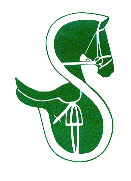 |
 |
 |
 |
 |
 |
| Parts of the Saddle |
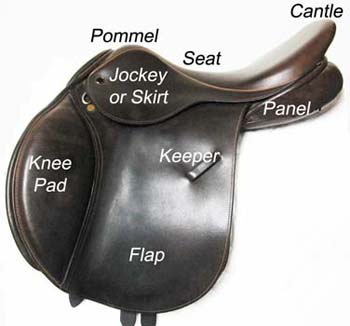 |
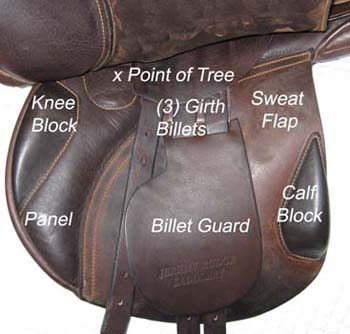 |
| Saddle Measurements |
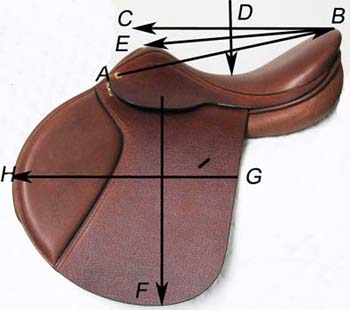 |
| A to B - Seat size B to C is a horizontal line when the saddle is in balance. D, where it bisects B-C in a perpendicular line, indicates the deepest part of the seat. D, where it bisects B-E, gives an indication of the depth of the seat. F, from the bottom of the stirrup bar (hidden under skirt) to the bottom of the flap, indicates flap length. G-H is flap width |
| Basic Saddle Care |
| New Saddles: Most quality new saddles can be used without any special preparation. It is usually beneficial to condition the saddle a couple of times in the first week or so with a good cream or ointment-type conditioner to make it less slippery and quicker to mold to horse and rider. Rub the conditioner into all parts of the saddle with your hands, gently rolling the leather as you go. If the rider prefers a darker colour, the judicious use of a quality oil can speed up that process, but test the oil for the amount of colour change on a small area first, and remember that less is more - over-oiling is very damaging and you can always reapply after it is absorbed. Regular Maintenance: Ideally, your saddle should be wiped off with a slightly-damp cloth after every ride to remove dust, grease and sweat, paying particular attention to the stirrup leathers and girth billets. Once every 10 rides or so, we recommend conditioning with an ointment or cream conditioner to replace any lost oils and to keep the saddle supple. If you are not an 'every ride' maintenance person, you will need to do a more thorough cleaning and conditioning periodically. After removing the stirrup leathers, clean the saddle thoroughly using your preferred saddle soap, rinse the excess off with a barely damp cloth and allow it to dry out of any direct heat source. Once dry, apply conditioner as needed. Do the same for your stirrup leathers and replace them on the saddle. |
| Saddle Selection |
If life was simple, a rider could go out and buy whatever saddle he or she liked the look of. It would have an appealing style; it would put the rider in a correctly-balanced position with an optimum level of support; close contact between horse and rider would be maintained, and the horse would have total freedom of movement due to a lack of restriction from the saddle. Horse and rider would work toward their goals in perfect comfort and balance. In reality, the above 'ideals' can be more difficult to achieve. A number of riders and trainers have enough experience to select saddles themselves, but more often, a rider is 'satisfied' through a combination of ignorance, low performance expectations, and an uncomplaining mount! At Sandridge, we will make every effort to help find the best saddle for you and your horse. Saddle shopping can be expensive, time-consuming, and, at times, very frustrating - but the benefits of a correctly-fitting saddle will be appreciated for many years to come. "...Again, just wanted to express to both of you how much your assistance and patience have meant to both Bentley and myself!!" (D.Clark) |
| Types of Saddles |
| JUMPING SADDLES |
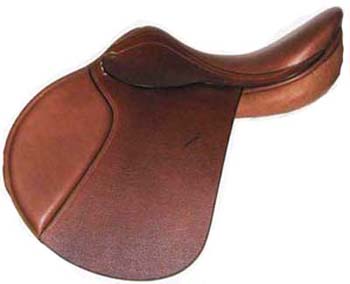 |
| Designed to provide the rider with optimum balance when riding with a shorter stirrup over fences. Jumping saddles tend to have more forward flaps, shallower seats, and panels constructed to allow the closest contact between rider and horse. |
| DRESSAGE SADDLES |
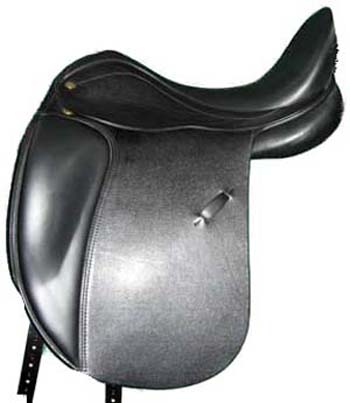 |
| Designed to provide the rider with optimum balance and support when riding with a longer stirrup on the flat. Dressage saddles tend to have straighter flaps, deeper seats, and larger thigh rolls or blocks. The panels are constructed to disburse the rider's weight over a larger area of the horse's back while allowing maximum freedom of movement. |
| ALL-PURPOSE SADDLES |
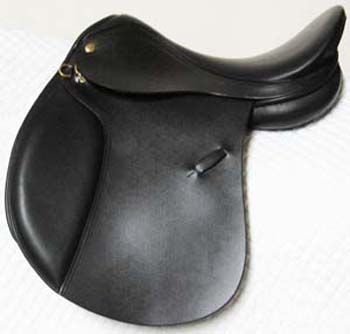 |
| Designed to provide the rider with a comfortable, fairly central seat for riding on the flat, but with flaps placed more forward to allow for a jumping-length stirrup. All-purpose saddles are well-suited for pleasure riding and fox-hunting, and allow a ride to use the same saddle for basic jumping and flatwork. |
| CROSS-COUNTRY SADDLES |
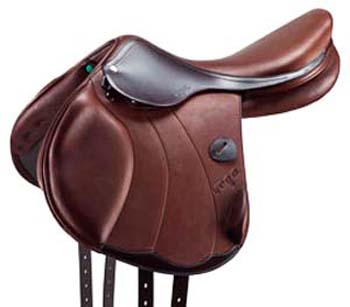 |
| Designed to enable the rider to gallop and jump across country with short stirrups in a secure, balanced position. Cross-country saddles are built for a specific purpose, but may also suit riders for show jumping. They usually have a fairly shallow seat, very forward flap placement, and often have long billets to reduce the bulk of girth buckles under the rider's legs. |
| PONY SADDLES |
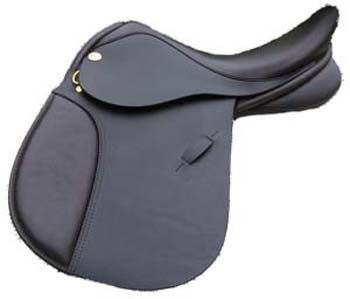 |
| Designed to be properly balanced on the rounder body and lower wither of the typical pony, with the seat and flaps proportioned correctly for the smaller rider. Jumping, Dressage, and All-Purpose saddles are available from sizes 14" - 16" for the junior rider and pony or small horse. |
| Questions to Consider Before You Shop* |
| What type of saddle do you need? |
| Dressage? All-Purpose? Jumping? What discipline do you train in and what do you hope to do in future? |
| What is your budget? |
| New saddles range in price from just under $ 1,000.00 to over $ 5,000.00 The larger your budget, the more options you will have. |
| What about your horse? |
| Is the saddle to be used on one horse, or many? To fit one horse, it is helpful to know his size, including his type/breed, general build and conformation. How old is the horse? What is his body condition? (Thin, under-developed? Fat?) What is his level of training, and how much work is he doing? |
| Rider information |
| The rider's build - height and weight. Age (a growing child, or an adult?) Any physical limitations? Rider's experience and ambition. Riding frequency. |
| *The more information that is available at the beginning of the process, the easier it is to select appropriate saddles to try. |
| Saddle Trial Policy |
| We encourage you to ride in the saddle (or saddles) you are interested in. We have protective covers for the stirrup leathers to prevent undue marking of the flaps, but you can use your normal saddle pad and girth and test ride the saddle in a lesson, on a trail - or whatever is necessary to determine if the saddle fits well and is comfortable. There is a $ 25.00 charge per saddle for trials, however ALL TRIAL FEES ARE FULLY APPLIED to the purchase of a new saddle from us. Shipping fees to you will be charged at their cost unless a saddle is bought; they will again be applied against the purchase; return shipping is at your expense. |
| Saddle Shopping with Sandridge |
| 1) Appointment The saddle showroom is open from 12:00-4:00 daily and you are welcome to browse through the roughly 150 saddles in stock. For the best possible advice, we suggest you make an appointment with Tracey, who is familiar with the fit and attributes of all our saddles. |
| 2) Meeting(s) Tracey will meet with you at the shop to discuss your needs, as well as see you sit in different saddles and make suggestions. The colours and options available on the different models will also be explained. If there is a saddle or saddles of interest, they may be taken out on trial. We have protective covers for the stirrup leathers, allowing you to use them so you are able to have a lesson, go on a hack, or whatever is required to feel confident the saddle is the right one. A second meeting may take place to review how the saddles did or did not work out. |
| 3) In-stable Consultation* We can help arrange for an appointment with Vicky Chalmers of Stuff-It Saddle Fitting. Vicky can bring a number of saddles to your stable to try on the horse. She will assess the horse and the way the saddles fit, and watch you ride if necessary. For those who don't have access to someone experienced with saddle fit, this is the best way to prevent future problems and ensure the horse will be comfortable. *There is a fee for this service, offered from Eastern Ontario to Quebec City. |
| Links of Interest |
| Changing Gullet Bars: Pessoa X-Change System (youtube) General: Kent & Masters Saddles Styles and Fitting, Changing the Gullet Bars (youtube) |
| Back to: Top of Page - Saddles - Archives |
